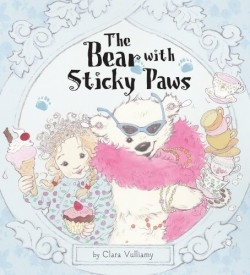The Bear with Sticky Paws
It is nine in the morning and Lily just isn’t in the mood for her morning routine. When we first meet her, she stands beside a table piled high with waffles, croissants, danishes, and toast, but none of it pleases her. Arms folded, pigtails awry, pajama-clad, Lily yells, “I don’t want all this breakfast!” before dumping a bowl of Cheerios onto the floor.
Not only will Lily not eat, she has decided she will not do anything, which includes all things related to personal hygiene. Frustrated, Mom “calls out, Stop!” and leaves, but this does not seem to matter to Lily, especially after a friendly (and hungry) bear appears at the door. Lily, however, is not prepared for how demanding her new fluffy friend is. She tries to keep him satisfied, supplying him with endless amounts of doughnuts, oatmeal, pizza, and, of course, honey sandwiches. She plays all kinds of games with him too, from dress up to hide and seek. Finally, exhausted, Lily demands that the bear wash his sticky paws and take a nap, but he boisterously refuses just as Lily had done when her mother made similar requests.
Refusing to be tamed, the bear leaves as quickly as he appeared. Relieved that normalcy is just around the corner, Lily eagerly agrees to clean up her friend’s mess when Mom asks, “What about this mess?”
The author-illustrator studied fine art at the Chelsea School of Art and the Royal Academy. Undoubtedly influenced by her noted author-illustrator mother, Shirley Hughes, Vulliamy has published numerous books for children, including the Baby Day board book series, Ellen and Penguin, and Goodnight Baby. The endpapers featuring a frolicking, carefree bear, and the bright watercolors on the double-spread title page showing a dripping swimsuit, let readers know right away that the characters in this book like to have fun without much responsibility.
Ripe for discussions and teachable moments, readers might point to clues in the illustrations that reveal that mother never actually leaves the house, and those who are familiar with The Cat in the Hat might enjoy talking about the similarities between the two books. Also, all of the featured goodies can be used to teach children to count up to twenty. Finally, adults can use this book to ask readers, especially those ages two to five, to be considerate of loved ones even if they are having a bad day.
Reviewed by
Kaavonia Hinton
Disclosure: This article is not an endorsement, but a review. The publisher of this book provided free copies of the book to have their book reviewed by a professional reviewer. No fee was paid by the publisher for this review. Foreword Reviews only recommends books that we love. Foreword Magazine, Inc. is disclosing this in accordance with the Federal Trade Commission’s 16 CFR, Part 255.

